Poultry, Fisheries & Wildlife Sciences
Open Access
ISSN: 2375-446X
ISSN: 2375-446X
Case Report - (2023)Volume 11, Issue 2
Experiential Learning (EL) is a concept and practice that encourages educators to intentionally include students in hands-on learning and focused reflection in order to advance knowledge, foster skills and entrepreneurship, and instil values. This article is going to cover the ELP programme which is being is function for almost 14 years in Indian agricultural universities. It will throw light on major success stories and a case report of ELP programme at college of fisheries (central agricultural university-Imphal), Agartala, Tripura, India. Moreover, it will cover the success in terms of real implications and revenue generation.
Experiential learning programme; Skilled professionals; Fisheries; Aquaculture conversion factor; 1 USD=82.82 Indian rupees
What is ELP?
The term "experiential" basically indicates that learning and growth take place by individual participation and experience, usually in a group setting, through observing, listening, and the study of theories or hypotheses, as opposed to formal instruction or training. EL is an engaging undertaking connected to the business curriculum. EL is used to improve abilities in project planning and execution, decision making, teamwork, approach to problem solving, accounting, quality control, marketing, and dispute resolution, among other things. The Indian council of agricultural research introduced the Experiential Learning Programme (ELP) into the curriculum of under graduate programmers in fisheries, veterinary, agriculture, horticulture, and other allied fields as one of the components under the students ready (Rural Entrepreneurship Aware) initiative in response to the nation's constantly growing population and the community of unemployed people's growth with the limited quota of government jobs (both state and central). "To prepare students to become job providers rather than job seekers" was the slogan. Thus, the curriculum places a strong emphasis on the value of helping students adopt an entrepreneurial attitude. Typically, the ELP is held during the second to last semester of the undergraduate curriculum [1-3].
A programme called experiential learning is founded on the ideas of "learning by doing" and "seeing believes."
Importance and benefits of ELP
• Increasing field knowledge and experience.
• Providing solid, hands-on experience and practice with the
challenges of intercultural differences for a significantly
changed personal mindset and a new perception of their
individual education programmes.
• It helps bridge the gap between a strictly academic setting and
a real workplace environment.
• Students also learn how to discover for themselves; rather than
relying on only provided material, they develop the
investigative skills to find answers to questions, as well as
various skills like negotiation, conflict resolution,
communicative skills, networking, etc.
• Provides an environment for cooperation among students as
well as a platform to take on leadership roles, make mistakes,
and learn by reflecting on them.
Major success in ELP
The experiential learning provided to undergraduate students has a profound impact on their mindset by equipping them with skills and motivating them toward holistic development, focusing more on specific dimensions to shape their career. Some examples of success stories in ELP include;
Dr. YSR horticultural university-Andhra Pradesh
Skill development and entrepreneurship/employment through:
• Production of quality planting material for fruit crops.
• Preparation of various forms of value added products.
• Poly-house cultivation and production of high-value crops
such as tomato, capsicum, cucumber, hybrid tea rose, and so
on that are sold in local market.
College of fisheries (central agricultural university- Imphal)-Tripura
The students have increased their thorough knowledge on various fields as following:
• Breeding of various fishes like rohu, catla, pabda, Indian cat
fishes, etc.
• Selling of various fish products like fish momo, fish samosa,
fish pickles, prawn pickles, etc.
• Hands-on experience with fish feed production as well as
handling different components of a fish farm.
• Interaction and selling of fish seed to farmers, etc.
Jawaharlal Nehru krishi vishwavidyalaya, Jabalpur-Madhya Pradesh
Skill development
• Mass production of bio-agents and bio-pesticides.
• Commercial fruit and vegetable production.
• Tissue culture and micro propagation of medicinal plants.
Products developed
• One step method for multiplication of entomopathogenic
fungi , , , .
• Production of high quality entomopathogenic fungi which is
highly effective against lepidopteron pests of legumes and
horticultural crops.
Mpuat, Udaipur-Rajasthan
Skill development
• Milk and value added milk products.
• Renewable energy sources.
Entrepreneurship/employment
• Licensed to SARAS Dairy Udaipur for sale of products
• Placement as senior executives in MNC’s such as Nestle,
Cadbury, ITC, Dynamix India Pvt. Ltd., tropilite foods etc.
ELP programme 2022 college of fisheries (CAU-I) Tripura
It is taken up during 8th semester of four (4) year degree program for the duration of five (5) months (March 2022-July 2022) but owing to the effects of the 2 year outbreak of the pandemic COVID-19 ELP programme delayed and started in the last semester.
The experiential learning programme under the college was conducted by 3 departments viz.
• Department of aquaculture (16 students).
• Department of fish genetics and reproduction (15 students).
• Department of fish processing technology (8 students).
Department of Aquaculture (AQC)
To maximize sustainable resource utilization and revenue generation, the department of aquaculture has selected the "integrated semi-intensive aqua farming model" as its primary model. The 5 components under the model/aquaculture department are: Fish farming, pabda seed production, pig rearing, poultry raising and fish feed production (Figure 1).
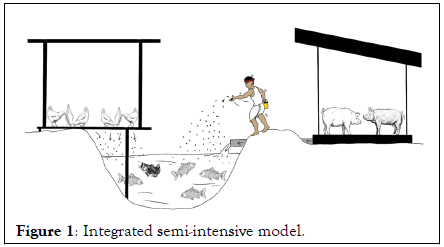
Figure 1: Integrated semi-intensive model.
Fish farming: Pond management is done for better production and benefit; divided into 3 practices (Figure 2).
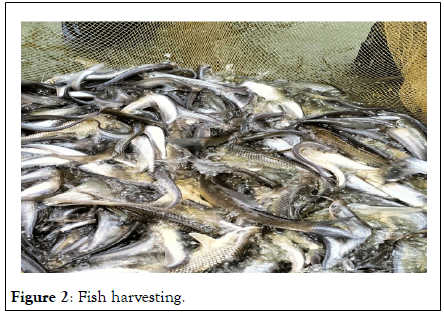
Figure 2: Fish harvesting.
Pre-stocking management: Dyke cleaning, netting, liming and manuring are done to increase productivity per unit area of pond.
Stocking: There were 6 different species cultured during the ELP period viz. Labeo rohita, Labeo catla, Cyprinus carpio, Labeo gonius, Puntius sarana, Cirrhinus mrigala. More emphasis was given on carps due to their availability and demand from customers as well as ease in the growth process during the limited culture period.
Post-stocking: Management practices like dyke cleaning of marginal aquatic weeds, netting to remove cannibalistic and unwanted weed fish, liming in proper dose to avoid pH fluctuation. The culture practice here was based on semi intensive model so natural productivity of the pond was given much importance too (Figure 3).
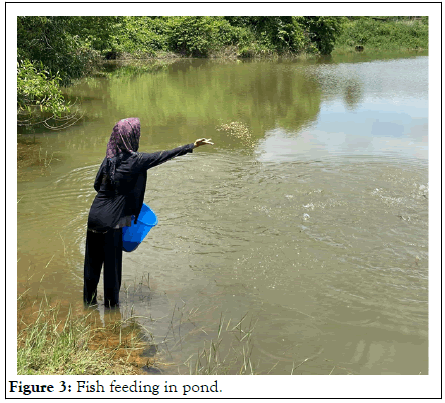
Figure 3: Fish feeding in pond.
Pabda seed production: Breeding of pabda was done using ovatide hormonal administration, taken care until it reaches the fry and fingerling stage then sold in oxygen filled bags to various farmers (Figure 4).
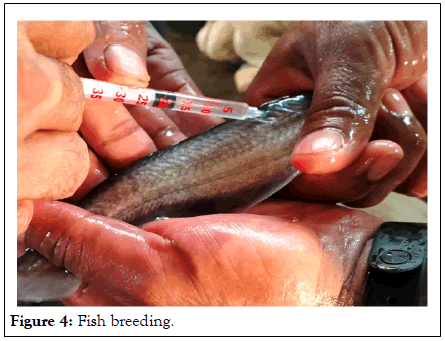
Figure 4: Fish breeding.
Pig rearing: A total of 6 pigs were reared following management practices like cleaning the piggery house twice a day (morning and evening), deworming, castration, proper feed management (Figure 5).
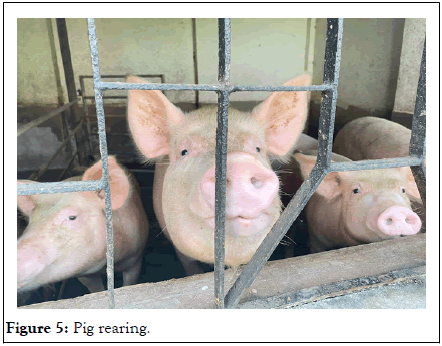
Figure 5: Pig rearing.
Poultry raising: 450 number of chicks were reared in a period of 2 months-3 months each in a properly maintained chicken coop provided with proper air flow, feed and water as well as proper vaccinating of chicks at the right timing to prevent any form of disease that may occur (Figure 6).
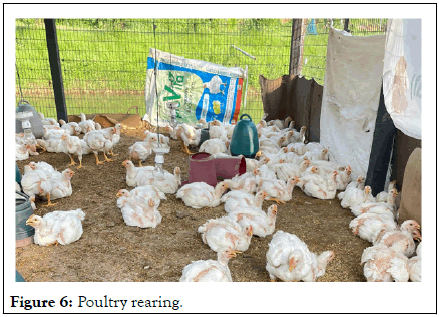
Figure 6: Poultry rearing.
Fish feed production: Floating pelleted feed are made and sold in properly packaged bags at 38 rs/kg by using major ingredients maize/corn, mustard oil cake, dry fish, broken wheat, rice bran and dana/cattle feed (Table 1 and Figure 7).
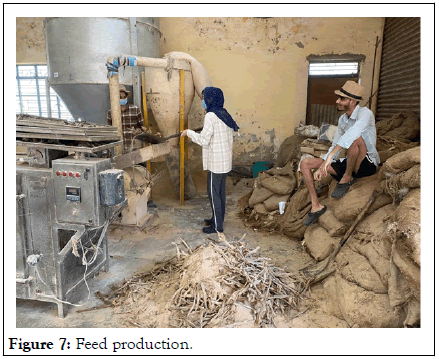
Figure 7: Feed production.
| S. No. | Ingredients | Total expenditure | Total revenue generated | Net profit |
|---|---|---|---|---|
| 1 | Feed production | Rs. 2,50,900 | Rs. 3,48,750 | Rs. 97,850 |
| 2 | Fish farming | Rs. 64,038 | Rs. 1,19,344 | Rs. 55,306 |
| 3 | Pabda seed prodution | Rs. 7,400 | Rs. 52,800 | Rs. 45,400 |
| 4 | Poultry | Rs. 81,042 | Rs. 91,501 | Rs. 10,455 |
| 5 | Piggery | Rs. 40,980 | Rs. 81,000 | Rs. 40,020 |
| Total | Rs. 4,44,360 | Rs. 6,93,395 | Rs. 2,49,031 | |
| Total revenue=Rs. 6,93,395; Total expenditure= Rs. 4,44,360; Total net profit= Rs. 2,49,031; Institutional share (25%)= Rs. 62,257; Students share (75%)= Rs. 1,86,773; Per student profit=Rs. 14,367 (net profit/no. of students)*3 students went for foreign training. | ||||
Table 1: Total revenue generation by AQC students.
Department of Fish Genetics and Reproduction (FGR)
The fish genetics and reproduction department consists of breeding and seed production of cars, catfish, and freshwater prawns. Labeo rohita, Labeo catla, Barbonymus gonionotus, Osteobrama belangeri, Cirrhinius reba, Heteropneustes fossilis, Claarias batrachus, and Macrobracium rosenbergii breeding practices were completed. A great deal of knowledge was gained about the culture method, hatchery management, and specific on-field experiences. Total 13 students joined FGR [4-6].
Total revenue generation by FGR students
• Total revenue from carp, catfish and prawn hatchery=Rs. 1,63,220.
• Total expenditure=Rs. 28,000.
• Total net profit=Rs. 1, 35,220.
• Institutional charge (25%)=Rs. 33,805.
• Net profit (75%)=Rs.1,01,405.
• Per student profit=Rs. 7800 (net profit/no. of students).
Department of Fish Processing Technology (FPT)
The Fish Processing Technology (FPT) department mainly deals with the production and sale of value-added food products like fish pickles, fish kurkure, fish momo, fish samosa, fish kimbbap, fish roll etc., as well as the operation and sale of these products and more in the FPT canteen stall provided by the college. The use of equipment and machinery in food processing fields was also taught and used. Total 8 students joined FPT.
Total revenue generation by FPT students
• Total revenue=Rs. 1, 16,330.
• Total expenditure/cost of production=Rs. 80,000.
• Total net profit=Rs. 36,330.
• Institutional share (25%)=Rs. 9,082.
• Students share (75%)=Rs. 27,248.
• Per student profit=Rs. 3,406 (net profit/no. of students).
Every facility, including initial investment, technical know-how, infrastructure, and moral support, was supplied by the college and departments to ensure the program's success. By employing various tactics, all three departments' students put in a lot of effort and produced a respectable amount of income. Due to the pond facilities and feed production facility, the aquaculture department made the most money. The breakdown of the total income and net profit produced by the various departments is as follows (Table 2).
| Department | AQC | FGR | FPT |
|---|---|---|---|
| Total revenue | Rs. 6,93,395 | Rs. 1,63,220 | Rs. 1,16330 |
| Total profit | Rs. 1,86,774 | Rs. 135,220 | Rs. 36,330 |
| Total expenditure | Rs. 4,44,360 | Rs. 28,000 | Rs. 80,000 |
| Institutional charge (25%) | Rs. 62,257 | Rs. 33,805 | Rs. 9,082 |
| Net profit (75%) | Rs. 2,49,031 | Rs. 1,01,405 | Rs. 27,248 |
| Share per student | Rs. 4,367 | Rs. 7,801.15 | Rs. 3,406 |
| Total profit by all the departments=Rs. 3,58,324 | |||
Table 2: Profit of all the departments.
The students encountered certain limitations as well, but they also had the opportunity to learn and overcome these difficulties in a business environment:
• Rat and fungus related deterioration.
• Grass around facilities that serve as a haven for snakes.
• Frequent power outages.
However, liberty, staff support, flexibility, teamwork, relevance to real-world situations, No authority anxiety and adaptability are among factors that inspired the students to work with a positive attitude.
The programme is a huge success in terms of providing actual skill development, practical experience, and on-field training to all of the students who are enrolled in it with handsome revenue generation. As a result, students, the nation's young, and the future's hope are given the required real-world skills to create their own jobs rather than relying on government quotas. As a result, it can narrow the wide disparity in unemployment throughout the nation.
Author wish to thank the authorities of college of fisheries (central agricultural university –Imphal), Agartala, Tripura, India and Dr. Arun Bhai Patel, HOD and managing director (dept. of aquaculture) for all his support, for giving the essential facilities, and would like to acknowledge Dr. Gusheinzed Waikhom, Dr. Pradyut Biswas, Dr. S. Khogen Singh and helping staff for their thoughtful support and direction throughout the program.
The author declares that there is no conflict of interest.
There is no funding source available.
[Crossref] [Google Scholar] [PubMed]
Citation: Pawar L, Brahmacharimayum PD (2023) Experiential Learning Programme (ELP): An Approach towards Developing Skilled Professionals. Poult Fish Wildl Sci. 11:232.
Received: 05-Jan-2023, Manuscript No. PFW-23-21274; Editor assigned: 09-Jan-2023, Pre QC No. PFW-23-21274; Reviewed: 23-Jan-2023, QC No. PFW-23-21274; Revised: 06-Mar-2023, Manuscript No. PFW-23-21274 ; Published: 13-Mar-2023 , DOI: 10.35248/2375-446X.23.11.232
Copyright: © 2023 Pawar L, et al. This is an open-access article distributed under the terms of the Creative Commons Attribution License, which permits unrestricted use, distribution, and reproduction in any medium, provided the original author and source are credited.